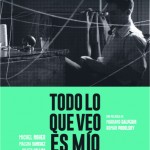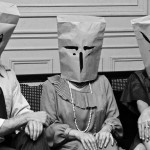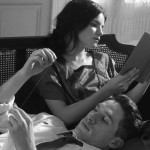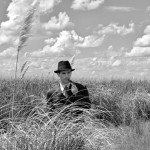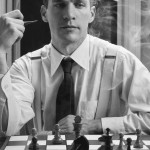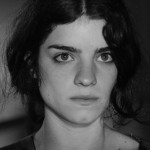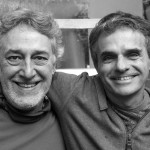Everything I see is mine
Tout ce que je vois est a moi
– Technical Info / Información Técnica:
(2017) / 01:23:00 / Sony fs7, Lent carl zeiss 2.1 / 24 fps / 16:9 / ntsc / B&W / 5.1 / argentina
– Short Synopsis / Sinopsis Corta:
Having already caused a revolution in 20th-century art, Marcel Duchamp travels to Buenos Aires in 1918 with his friend Yvonne Chastel. “Everything I See Is Mine” reconstructs the mysterious and remarkable stay of the celebrated French artist in that city.
Habiendo revolucionado el arte del siglo XX, Marcel Duchamp viaja junto a su amiga Yvonne Chastel a Buenos Aires en 1918, huyendo del clima bélico imperante. “Todo lo que veo es mío” reconstruye la misteriosa estadía del célebre artistas francés en esa ciudad.
– Synopsis / Sinopsis:
Having already caused a revolution in the art world both in Paris and New York, Marcel Duchamp – together with his friend Yvonne Chastel – decide to leave behind the art centers of the world in 1918 and take a journey to Argentina. The year he lived in Buenos Aires is one of the lesser known periods of his brilliant career.
Set in the city of Buenos Aires at the beginning of the 20th century, Everything I See Is Mine reconstructs the famous French artist’s mysterious and remarkable stay in this city, based on Duchamp’s letters to his friends and sisters. The city’s society, distant when measured by a map but so close to European customs of that time, amazes, please and outrages Duchamp, whose talent and intelligence changed the art form forever.
What did the creator of the famous “ready-mades” do in the city that had begun to awaken the world’s interest? What surprises awaited him when he came into contact with the local people and their customs? This is the reconstruction of a period that illuminates one of the least known phases in the great French artist’s life.
Habiendo ya revolucionado el arte del siglo XX, Marcel Duchamp viaja junto a su amiga Yvonne Chastel a Buenos Aires en 1918. La joven pareja y se instala en un austero departamento del centro de la ciudad. Marcel comienza a tomar notas para sus futuros trabajos artísticos y en sus ratos libres -que no son pocos- juega al ajedrez. Junto a Yvonne recorren las calles y disfrutan de la comida sabrosa y abundante. En algunas ocasiones se suma a los paseos Katherine Dreier, gran amiga de Marcel, que también se encuentra en Buenos Aires. Al cabo de algunos meses, la atmósfera de una sociedad cerrada a las ideas y las costumbres de la modernidad, cambia los planes de Marcel e Yvonne y los lleva a tomar caminos diferentes. ¿Qué hizo el creador de los famosos ready mades en esa ciudad? ¿Cuánto influyó en sus creaciones posteriores esa voluntaria estadía en tierras tan alejadas de los centros de la vanguardia artística? Ambientada en la Buenos Aires de principios del siglo XX, Todo lo que veo es mío reconstruye, cien años después, una de las etapas menos conocidas del gran artista francés y nos da pistas para entender por qué escribió poco antes de regresar a Europa: “Cuando nos volvamos a ver habré cambiado muchísimo.”
– Long Synopsis / Sinopsis Larga:
In 1918, when he is little more than 30 years old, Marcel Duchamp is already a well-known artist in New York and Paris for his irreverent and provocative work, which would transform 20th-century art. By mid-1918, after the U.S. has been involved in WWI for several months, Marcel decides to keep his distance from the prevailing war atmosphere and leaves New York for a much more peaceful and picturesque destiny: the city of Buenos Aires, Argentina. He is accompanied on this adventure by his friend Yvonne Chastel, also a young artist and who, like Marcel, frequented the avant-guard events of that time. After an almost month-long journey across the ocean, the young couple arrives in Buenos Aires and move into an austere apartment in the city center. Marcel begins to make notes for his future artistic work, and in his free time – which is anything but short – plays chess. Together with Yvonne, they walk the city streets and enjoy the tasty and abundant local food. They are sometimes joined on these outings by Katherine Dreier, a good friend of Marcel’s, who is in Buenos Aires at the time as a correspondent for a New York magazine. But after a few months, the stifling atmosphere of a marginal society, not at all open to modern ideas and customs, changes Marcel and Yvonne’s plans and leads them down separate paths. What did the creator of the famous readymades do in that city which was awakening to the world at that time? How much did his voluntary stay in a land so distant from the centers of avant-guard art, influence his later creations? Set in Buenos Aires at the beginning of the 20th century, Everything I See Is Mine reconstructs, one hundred years later, one of the least known phases of this great French artist, and gives us a clue into understanding why he wrote just before returning to Europe: “When we meet again, I’ll be completely changed.”
En 1918 y con algo más de treinta años, Marcel Duchamp, ya es conocido en Nueva York y París por una obra irreverente y provocativa que terminaría revolucionando el arte del Siglo XX. A mediados de ese año, ante el agravamiento del clima bélico que tiene en vilo a los Estados Unidos por su participación en la Primera Guerra Mundial, Marcel decide tomar distancia y parte desde Nueva York hacia un destino más sereno y pintoresco: la ciudad de Buenos Aires, en Argentina. Lo acompaña en la aventura su amiga Yvonne Chastel, una joven artista que como él, frecuenta las vanguardias de la época. Luego de cruzar el océano en una travesía de casi un mes de duración, la joven pareja llega a Buenos Aires y se instala en un austero departamento del centro. Marcel comienza a tomar notas para sus futuros trabajos artísticos y en sus ratos libres -que no son pocos- juega al ajedrez. Junto a Yvonne recorren las calles de la ciudad y disfrutan de la comida sabrosa y abundante. En algunas ocasiones se suma a los paseos Katherine Dreier, gran amiga de Marcel, que también se encuentra en Buenos Aires como corresponsal de una revista neoyorquina. Pero al cabo de algunos meses, la atmósfera cerrada de una sociedad periférica no muy abierta a las ideas y las costumbres de la modernidad, cambia los planes de Marcel e Yvonne y los lleva a tomar caminos diferentes. ¿Qué hizo el creador de los famosos ready mades en esa ciudad que por entonces comenzaba a despertar al mundo? ¿Cuánto influyó en sus creaciones posteriores esa voluntaria estadía en tierras tan alejadas de los centros de la vanguardia artística? Ambientada en la Buenos Aires de principios del siglo XX, Todo lo que veo es mío reconstruye, cien años después, una de las etapas menos conocidas del gran artista francés y nos da pistas para entender por qué escribió poco antes de regresar a Europa: “Cuando nos volvamos a ver habré cambiado muchísimo.”
– Director´s Biography / Biografía del Director:
MARIANO GALPERIN
Mariano Galperin was born in Buenos Aires in 1962. From his very early years, he began his career as a photographer, participating in artistic and institutional exhibition circuitry in Buenos Aires. He settled down in the United States during 1985, where he studied cinema at the New York University and photography at the Parsons School of Design. After returning to Argentina was invited to show his work at Instituto de Cooperación Iberoamericana, Museo Nacional de Bellas Artes, Estudio Giesso, Estudio Abierto, Centro Cultural Recoleta, Cronopios, Museo de Arte Moderno de la Ciudad de México, Limelight Gallery NY, Arco – Madrid. He began his career as a film director in 1993.
Mariano Galperin nace en Buenos Aires en 1962. Desde temprana edad comienza su carrera de fotógrafo realizando exposiciones en circuitos artísticos e institucionales de Buenos Aires. Viaja en 1985 a Estados Unidos donde se radica. Estudia cine en New York University y fotografía en Parsons School of Design. De regreso a Argentina realiza muestras en: Instituto de Cooperación Iberoamericana, Museo Nacional de Bellas Artes, Estudio Giesso, Estudio Abierto, Palais de Glace, Centro Cultural Recoleta, Cronopios, Museo de Arte Moderno Ciudad de México, Limelight Gallery NY, Arco – Madrid. En 1993 comienza su carrera como cineasta.
Mariano Galperin nace en Buenos Aires en 1962. Es Director, guionista y fotógrafo. Dirigió los siguientes largometrajes: 1000 Boomerangs (1994), Chicos Ricos (2000), El Delantal de Lili (2004), Futuro Perfecto (2008), 100 Tragedias (Junto a S. Bizzio, 2009), Dulce de Leche (2012), Su Realidad (2015).
ROMAN PODOLSKY
Graduate in Education Sciences, theater director, dramatist. As the teacher was responsible for the Graduation Project of the Degree in Management of the UNA, where he is currently is a teacher in ³Direction IV². It dictates its seminars of performance, drama of the actor and of direction in the city of Buenos Aires and out of the country. His most important works as dramaturg and director: Harina, Guardavidas, Las Primas, Para qué vamos a hablar de la guerra, Globo flotando contra el techo de un shopping, La Reina de Castelar, Alacrán, o la Ceremonia y MSU, Movimientos sin utilidad.
Es Licenciado en Ciencias de la Educación, director de teatro, dramaturgo. Como docente fue responsable del Proyecto de Graduación de la Licenciatura en Dirección de la UNA, donde actualmente es titular de la materia Dirección IV. Dicta sus seminarios de Actuación, Dramaturgia del Actor y de Dirección en la ciudad de Buenos Aires y en el extranjero. Entre sus trabajos más destacados como dramaturgo y director pueden mencionarse «Harina», «Guardavidas», «Las Primas o la voz de Yuna», (versión teatral de la novela «Las Primas» de Aurora Venturini), «Para qué vamos a hablar de la guerra», «Globo flotando contra el techo de un shopping» de Alberto Rojas Apel, y últimamente «La Reina de Castelar, Alacrán o la Ceremonia» «Movimientos sin utilidad». Sus trabajos han sido presentados en diversos festivales nacionales y extranjeros, obteniendo destacadas menciones y premios. Junto a Mariano Galperín escribió y dirigió «Todo lo que veo es mío» sobre la estadía de Marcel Duchamp en Buenos Aires a principios del S. XX. Este trabajo es su primera incursión en el cine.
Es Licenciado en Educación, director de teatro, dramaturgo. Fue responsable del Proyecto de Graduación de la Licenciatura en Dirección de la UNA, donde actualmente es titular de la materia Dirección IV. Dicta sus seminarios en la ciudad de Buenos Aires y en el extranjero. Entre sus obras más conocidas figuran “Harina” y “Guardavidas”. «Todo lo que veo es mío» es su primera experiencia en cine.
– Director Statement / Declaraciones del Director:
It is not so much a question of showing from a biographical perspective what Marcel Duchamp did in the ten months he spent in Buenos Aires between 1918 and 1919, but of presenting that stay as a fluid of facts and images in which the objective and the subjective are intermingle, producing a multisense reverie. Our film takes place in the mind of Marcel Duchamp. Remember and imagine the trip with Yvonne Chastel to Argentina, playing chess, drinking, listening to tangos or sleeping. A kind of intimate bond with the city. Feeling like a true porteño.
No se trata tanto de mostrar desde una perspectiva biográfica, qué hizo Marcel Duchamp en los diez meses que pasó en Buenos Aires entre 1918 y 1919, sino de presentar esa estadía como un fluido de hechos e imágenes en el que lo objetivo y lo subjetivo se entremezclan, produciendo una ensoñación de múltiples sentidos. Nuestra película ocurre en la mente de Marcel Duchamp. Recuerda e imagina el viaje junto a Yvonne Chastel a la Argentina, jugando al ajedrez, bebiendo, escuchando tangos o durmiendo. Una suerte de vínculo íntimo con la ciudad. Sintiéndose un verdadero porteño.
– Overview / Ficha técnica:
Script / Guión: Mariano Galperín, Román Podolsky
Production / Producción: Marcela Avalos
Director / Director: Mariano Galperín, Román Podolsky
Cinematography / Dirección de Fotografía: Diego Robaldo
Art Director / Director de Arte: Lorena Ventimiglia
Sound Design / Diseño de Sonido: Pablo Gamberg, Guillermo Picco
Editing / Edición: Andrés Tambornino
Original Music / Música Original: Diego Tuñon
Cast / Actores: Michel Noher, Malena Sánchez, Julieta Vallina
– Festivals, Awards and Nominations / Festivales, Premios y Nominaciones:
– Mar del Plata International Film Festival; 11/2017; Argentina
– Pehuajo International Film Festival; 02/2018; Argentina
– MARFICI, Festival Internacional de Cine Independiente de Mar del Plata; 08/2018; Argentina
– Links:
http://www.amadafilms.com.ar/todo_lo_que_veo_es_mio.html
Facebook: https://www.facebook.com/todoloqueveoesmio/
– Contact / Contacto:
Gisela Chicolino
AMADA FILMS
Marcela Avalos

